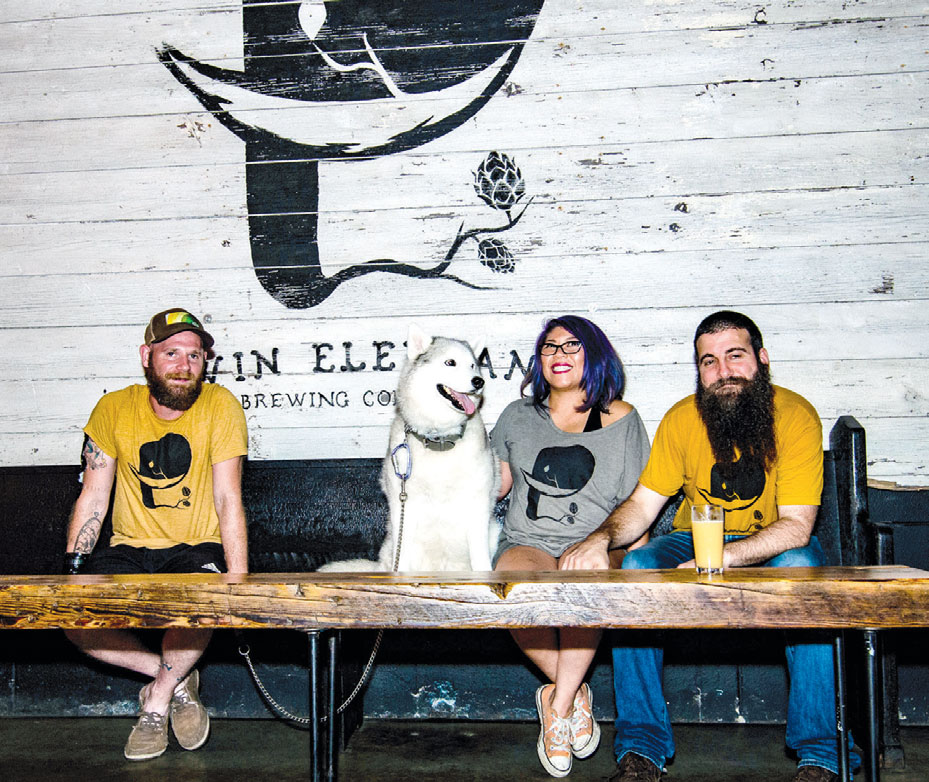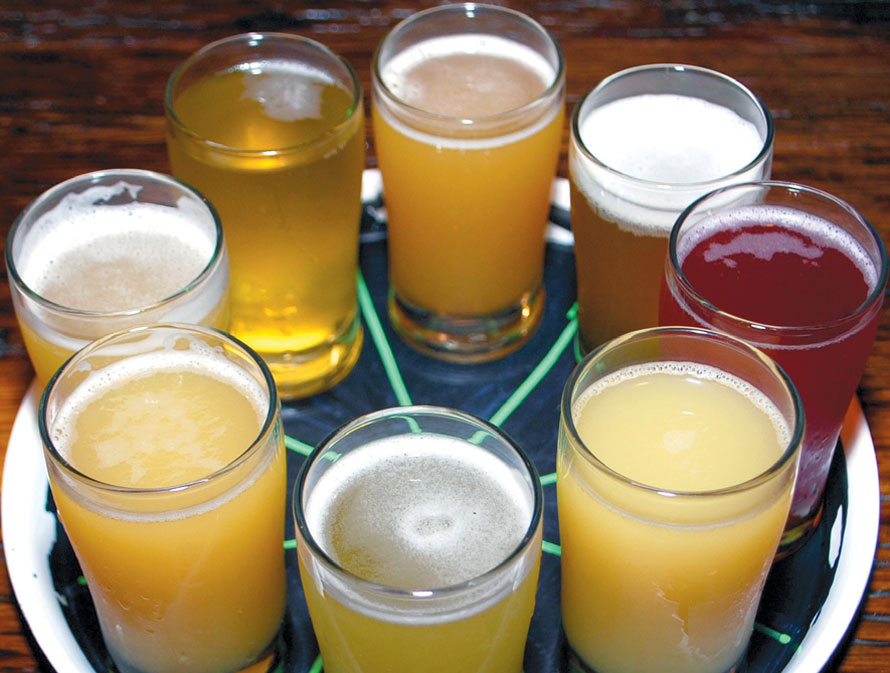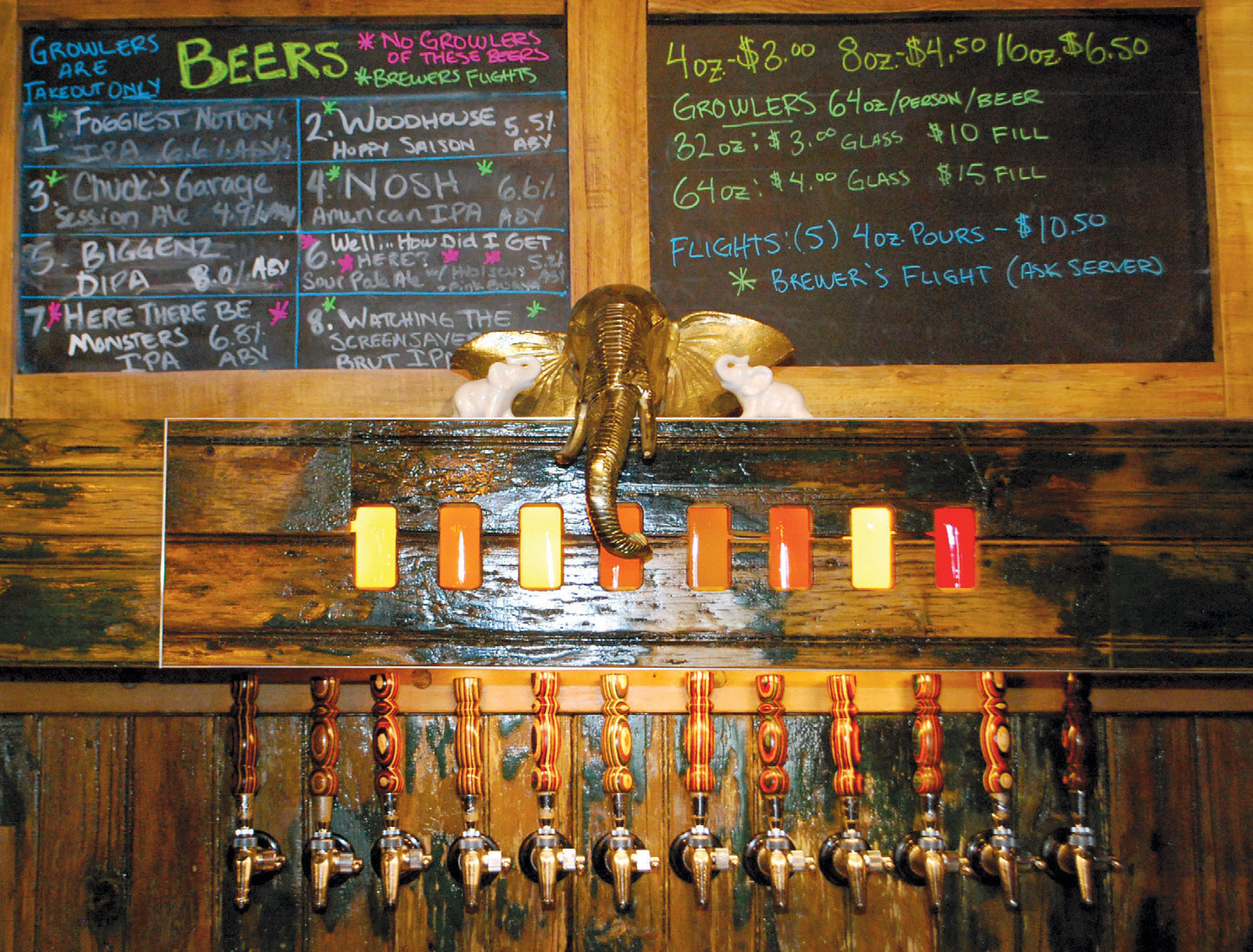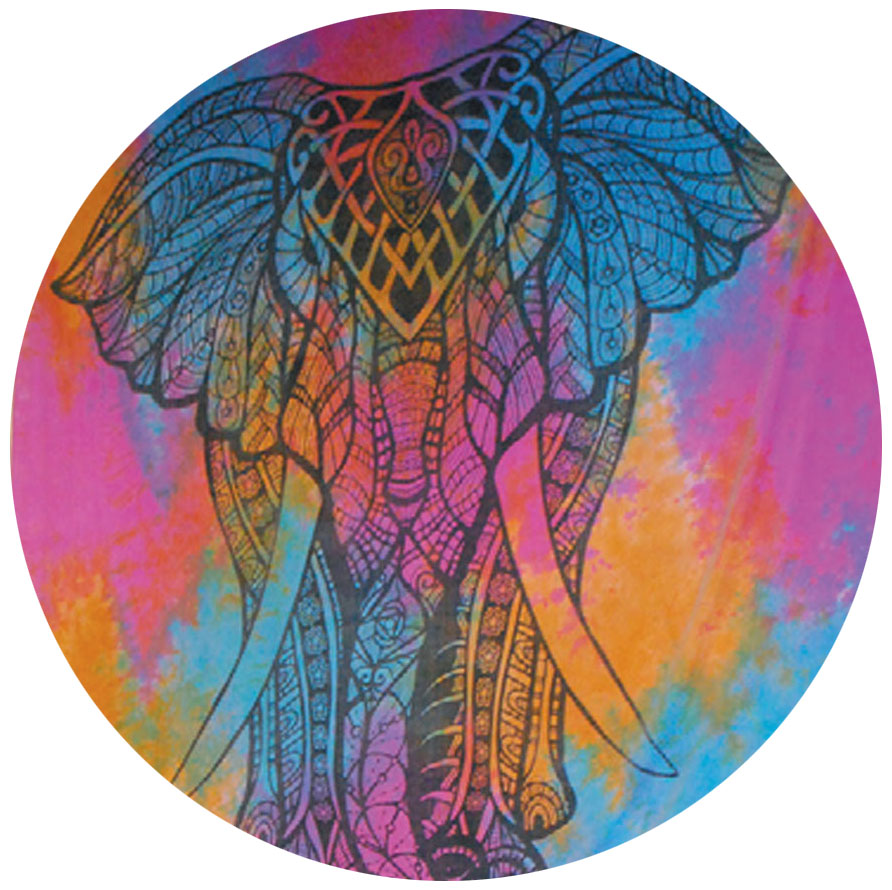Creative Juices
Tasting notes from Twin Elephant Brewing Company
In my craft beer travels, I’ve heard the phrase flagship beer tossed around with the same frequency that synergy is used in the archetypal conference room. We live in an age when a young brewery needs a brand before it perfects its first round of recipes, in which a taproom needs followers before it has regulars and in which Instagram can make or break a can release before the line even forms outside. But, tucked away on Watchung Avenue in Chatham is a small warehouse where one Saturday afternoon, a different kind of follower has gathered: into a line that pours out the door, down the steps and across a parking lot jammed with cars. Inside are gleaming cans of Gathering Clouds, a 6.4% ABV double dry-hopped American IPA. This is Twin Elephant Brewing Company, the antithesis of flagship beer.
A few hundred people will each leave with a single 4-pack of the hazy gold IPA, bursting with notes of lemon peel, pine needles and caramelized pineapple. A complex selection of hops, including Rakau, Vic Secret, Southern Cross, Galaxy and Motueka, round out the recipe, perfected by three of Union County’s resident hopheads, all self-taught and devoted to craft brewing.
Inside, the space is divided in two: on the left is the brew-house, in which head brewer Scott McLuskey is squeezing his way through nine judiciously-arranged 5-barrel fermenters when I arrive. He opens the valve on one and pours off a sample, then sets it on a stainless steel cart and drops in a hydrometer to test its final gravity. It’s a new recipe, featuring kveik yeast, a Nordic strain he’s selected and paired with brut enzymes to mirror the mimosa-like cocktail known as a “Monkey Julius”: Victory Golden Monkey and orange juice. The finished product will be dry, tangerine-like and potentially spicy from flaked rye added to the grain bill. “I still get to experiment,” he laughs, as though this weekend’s 600 visitors will expect anything less.

Scott McLuskey, Cindy DeRama and Tim Besecker
PHOTOGRAPH: LYNETTE PELUSO-CONN
“I still love formulating recipes around hops to see what they can do, either as a new beer or as a variant. It still gets me juiced when I hear about a new hop.” —Scott McLuskey, head brewer
A self-declared “disciple of the Brewing Network podcast,” McLuskey got his start home-brewing while studying journalism at St. Michael’s College, eventually filming a documentary on Vermont brewing for his senior thesis. Today, after a decade as a “beer geek,” imbibing countless articles, books and podcasts, he is one of three co-owners of a wildly popular nanobrewery and purveyor of New England–style IPAs, sours, fruit beers and everything in between. Should you ever ask “why?” of one of Twin Elephant’s experimental additions to the tank, the explanation you’ll get is half chemistry and half rule-bending spontaneity. Many of the concepts for their brews originated on a purple-and-green- stained whiteboard nailed to the brew-house wall, just behind a table loaded with more beakers. It’s labeled “IDEAS” and is scrawled with potential names, ingredients and hybrid styles written by anyone who can hold a Crayola marker.
“Every brewery, in some weird way, has an impression of what the owners did before,” McLuskey says as we make our way out into the tasting room, which was hand-built by the three owners and their families. McLuskey’s own background in carpentry is on display in the creative little alcove where we sit, framed by pallet-wood benches and a narrow table made of a reclaimed barn beam. Joining us are Cindy DeRama and Tim Besecker, the other two minds behind Twin Elephant.
I realize we lucked out finding a seat, as a young couple shimmies past us with a tray of 4-ounce sample pours to reach a tiny vacancy at the opposite end of the table. In fact, the loyal and enthusiastic crowd that packs the converted industrial space every Saturday is a melting pot of young and old, seasoned beer connoisseurs and cautious Miller-Coors devotees, both of whom are welcomed by the Twin Elephant staff in the same unassuming breath.
“We wanted to start small and watch it organically unfold,” McLuskey says when I ask about last summer’s upgrade to 5-barrel fermenters on the brewing floor. They had toyed with the idea of a 10- or even 20-barrel setup before opening in May 2016 with a 2-barrel system. At 62 gallons per batch—the equivalent of just four standard kegs—the 2-barrel system was still a big step up from the 5-gallon equipment on which they’d gotten their start as homebrewers…and brewed all the beer for DeRama and Besecker’s wedding in 2014. Now, that 5-gallon homebrew setup functions as a pilot system for testing out new recipes.
Space was also a concern, as a 20-barrel brewery would have taken up the entire warehouse, tasting room and all. That was never really an option, McLuskey explains, because the idea for Twin Elephant went beyond the brew-house. “It’s never been our approach to light the world on fire with this grand scheme,” he says. “We knew we wanted a taproom from the beginning, and even during construction it was always friends and family in here with us.”
The final aesthetic is as much a product of the community that fills it as of the hands that built it, and many of the regulars have contributed their skills as well— whether painting signs or designing labels, logos and custom T-shirts. One such patron is Mike Banker, the owner at Eco Bee Supply in Morristown, who contributed raw honey for several unique brews, including a hibiscus-and-honey variant of the popular “Table Legs” saison. Banker met the brewers shortly before a swarm of wild honeybees made their home in a house that McLuskey was working on, and one extraction later, Twin Elephant had 40 pounds of local honey and Eco Bee had a newly transplanted colony. “I do it because I love it,” Banker says of his beekeeping business. “So I understand why when I showed up with my 5-gallon bucket, the first thing they wanted to do was give me a tour.”
Even since the upgrade to 5-barrel, 155-gallon batches, Twin Elephant occasionally sells out of a beer or two before the weekend is over. This is no accident. In fact, the shelf life of a New England– style “juice bomb”—with 5 to 7 pounds of hops added post-fermentation— is a matter of weeks, not months, and hazy IPAs like Gathering Clouds are meant to be stored cold and enjoyed fresh. The consumption of the other styles on the diverse 8-beer taplist is not as time-critical, but beers like Diamonds and Pearls, a milk stout brewed with Boxwood Coffee beans, sell out almost as quickly. There are up to three new names on the chalkboard every week—one or two of which are usually entirely new recipes, and the majority of which don’t leave the taproom except in growlers. Twin Elephant is perhaps best known for its hop-forward offerings, but those comprise only a fraction of the ephemeral taproom offerings, which also include phenomenal one-off sours and beers conditioned on Jersey Fresh peaches, cantaloupe and even cucumber.

Twin Elephant’s small size and fresh-batch philosophy allow for some creative late additions to the fermenters, which themselves present another dilemma. Adding hops, fruit or other specialty ingredients directly into the beer after primary fermentation not only imparts the fragrant, tropical notes that hopheads love—or the unique pink hue of fresh raspberries—but also render the settled yeast difficult to harvest once secondary fermentation is complete. The problem? New yeast is expensive. But even more importantly, the flavors imparted by re-pitching third- or fourth-generation yeast are considered more complex and desirable than a first-generation brew. Still, the piney, dank aromas that emanate from the brewhouse as Twin Elephant brewers delightedly rip open giant bags of green hop pellets are always a sign of great beer to come and yeast well spent.
In the past five to seven years, DeRama explains, a world of new hops has opened up, and Twin Elephant now has access to varieties in New Zealand, Australia, Germany, France, England and the Czech Republic, as well as proprietary breeds like Simcoe and Citra, which, though still expensive, have become more affordable in the last few years as increased demand has led patent owners to license their growing rights to other farms. As the hop craze has heated up, though, the brewers’ own tastes have evolved. “Your palate goes through cycles,” she says. “Sometimes even hopheads need a break.” Lately, she’s been reaching for brown ales, and her co-founder for Chuck’s Garage, the tamest beer on the menu but a proud achievement for any brewer: a session ale that drinks like a lager. “I still love formulating recipes around hops to see what they can do, either as a new beer or as a variant,” McLuskey adds. “It still gets me juiced when I hear about a new hop.”
Besecker, whose own thirst for IPAs remains unquenched, sees a beer landscape today in which even wild variations on traditional styles are so accessible that craft beer neophytes can span years of tasting experience in mere weeks. “If you were new to the craft scene and said, ‘I’m gonna start drinking beer now,’ in two months you could work your way all over the map. I think about this long, arcing curve through beer that took me 20 years, and see people run through it now like a movie in fast-forward.” He describes to me a new friend on the beer rating app Untappd, whose first 50 check-ins traverse almost as many styles. Saturation of the craft beer spectrum, he says, might lessen the sense of discovery for a new palate, or even make inaccessible the nuance within each style. Yet, as with everyone who works the taproom, there is no dismissal or condescension in his tone. Humility is built into the Twin Elephant vocabulary.
The care with which the three owners listen to each person in the tasting room and brewhouse, myself included, forms the center of an ecosystem—wherein a community gets creative, and creativity reaches the community. From the beginning, Twin Elephant piqued the curiosity of neighboring towns and welcomed in a new generation of craft beer drinkers, which itself spans generations. In the brewery’s first two years of operation, its weekly taplist began to attract more seasoned palates, and its brewers, in perhaps their most creative feat yet, carved out a space in which the two crowds can do what the staff themselves love the most: hang out and talk about beer.
As of the morning of Aug. 4, Twin Elephant has brewed 355 batches of beer, more than 200 of which were entirely different recipes—and no matter where the ideas originate, whenever Scott McLuskey has to erase the whiteboard, he takes a picture of it first. When Cindy DeRama runs the numbers, it’s only after the next batch of local ingredients has been chosen. And when Tim Besecker pours a finished beer and talks tasting notes, all bets are off. “You have to let go of it,” he says of the beer when it leaves the tap, the cans when they leave the case, and the glass when it leaves the bar. “That’s when the brewery becomes bigger than the brewer.”
TWIN ELEPHANT BREWING COMPANY
13 Watchung Ave.
Chatham
973.507.9862
twinelephantbrewing.com
Hours: Thursday & Friday 4–10pm Saturday 12–10pm; Sunday 12–6pm
TASTING NOTES:
Twin Elephant’s Most-Used Hops
In the same way that chemical elements come together to form compounds with entirely different properties, hop varieties yield unique flavors when blended together, combined at different ratios, and added at different times during the brewing process. Below are tasting notes of Twin Elephant’s favorite “elements.”
Citra (United States): sweetness of navel oranges, bittersweet of pink grapefruit
Mosaic (United States): fresh blueberries, tangerines, slightly piney
Vic Secret (Australia): dank, reeks of pineapple, slightly citrusy
Galaxy (Australia); mango, guava, tropical notes
Southern Cross (New Zealand): black pepper, lemon peel, spicy and earthy
Motueka (New Zealand): citrus profile, lemon and lime
“I still love formulating recipes around hops to see what they can do, either as a new beer or as a variant. It still gets me juiced when I hear about a new hop.” —Scott McLuskey, head brewer






